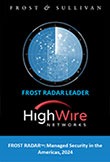More than 5 billion pieces of personal information were stolen in 2021, according to IT Governance. With the record number of breaches, managed services providers (MSPs) and their business clients are investing more than ever in cybersecurity solutions. In response, cybercriminals are evolving their tactics at a blistering pace. It’s hard to keep up, much less get ahead.
The cybersecurity “arms race” is further complicated for MSPs and their clients by challenges such as:
- Misconfigurations – Security risks arise when systems or applications aren’t configured properly, which happens quite frequently. In 90 percent of applications examined by the Open Worldwide Application Security Project (OWASP), some form of misconfiguration was found. Security misconfigurations occur due to human error, lack of knowledge, lack of proper procedures, or when new systems or applications are added to a network without adequately assessing and addressing potential security risks.
- Fragmentation – Fragmentation occurs when the security tools don’t talk to each other. Even a best-in-class security stack won’t perform if the individual tools aren’t integrated or interoperable.
It’s critical for MSPs and their business clients to make the most of cybersecurity investments and ensure those tools are deployed correctly and operationalized to work together.
What is operationalized cybersecurity?
In the broadest sense, operationalization is turning abstract concepts into measurable objectives. Operationalizing cybersecurity means:
- Bringing cybersecurity in line with other business functions
- Investing in people, processes and tools
- Ensuring the tools provide high-value, actionable data for risk management
What are the challenges to operationalizing cybersecurity?
The continual challenge in cybersecurity is three-fold:
- Too few security-skilled personnel
- Too much data
- Too many tools
With the talent shortage and the never-ending deluge of data, the best lever to pull is finding the tools to help bridge those gaps. However, it’s not a matter of simply adding more tools. That actually can exacerbate the situation by generating more data and requiring more people to manage them. Instead, it’s about finding the right tools that:
- Work together to reduce risk
- Correlate and analyze data
- Take appropriate action
Operationalizing cybersecurity, then, is about bringing together the right tools, layering on visibility and know-how, and automating data analysis and response actions.
A quick caveat about automation: You can’t run cybersecurity at scale without some automation, but it’s a mistake to think of automation as synonymous with “set it and forget it.” Instead, automation speeds up analysis and threat triage, alerting analysts to issues that need their attention.
How do you operationalize cybersecurity?
Every organization has its own toolsets. The average enterprise has 60-80 tools for cybersecurity alone. Using these cybersecurity tools to their full potential requires a strategy such as the following steps:
- Create a plan, or what is known as a cybersecurity architecture.
- Plug in the right tools.
- Integrate these tools to reveal your complete risk picture.
- Build in responses to data.
- Plug in solutions to address any gaps.
The key to success is ensuring the strategy is deployed across the organization (not solely in the IT department), measuring its effectiveness and tweaking where needed.
Remember: Every process or system is inherently flawed because it’s only as good as the data it leverages at a point in time. You must refine it as new data becomes available.
How can High Wire Networks help MSPs operationalize cybersecurity?
Cybersecurity requires resources – both technological and human. If you don’t have resources in-house, the smart move is to work with a partner like High Wire Networks that can operationalize cybersecurity for threat prevention, detection and response.
High Wire Networks’ channel-only approach to cybersecurity enables us to leverage insights from thousands of our partners’ business clients to build and deploy more resilient solutions.
Uniquely, High Wire Networks also recognizes the investments businesses have made in their cybersecurity tools. Rather than rip and replace, we help our MSP partners capitalize on their clients’ existing tech stack by using overlay automation tools that ingest and correlate data from all of them.
We build consistency at scale using a variety of tools and resources under the Overwatch Managed Cybersecurity umbrella, including:
- Managed Extended Detection & Response (MXDR) — MXDR is a unified approach to detection and response that collects and correlates all security tools to protect the entire enterprise attack surface.
- Security Orchestration Automation & Remediation (SOAR) — SOAR collects threat data, alerts security teams and automates responses. It also uses AI to learn and predict threats. SOAR consolidates data from across clients’ security stacks and eliminates the risk of vendor lock-in.
- Security Operations Center as a Service (SOCaaS) — Overwatch Managed SOC combines expertly trained security analysts with SOAR capabilities to automate alert handling, reduce remediation time and minimize the impact of cyberattacks. What would take analysts minutes can be done in seconds and thousands of times simultaneously, resulting in greater protection for our MSP partners and their customers.
- Network Operations Center as a Service (NOCaaS) — High Wire employs network analysts and the latest advances in observability, AI and machine learning to deliver Overwatch managed NOC services. Plus, it integrates seamlessly with our managed SOC services and our “top of stack” next-gen SOAR tool.
Cybercrime is evolving in “cyber time.” It’s more critical than ever to ensure your cybersecurity investments are put to their best use with a unified approach to prevention, detection and response. By collecting and correlating all security tools, organizations are better protected and better able to respond.
Ready to realize the benefits of operationalized cybersecurity?
Contact High Wire Networks to become a partner today.








